Announcement: Chapter quizzes are not working as of summer 2023.
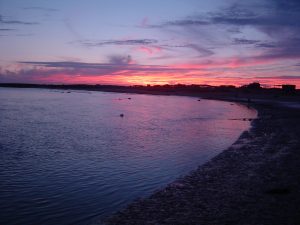
12 Coastlines
KEY CONCEPTS
By the end of this chapter, students should be able to:
- Describe how waves occur, move, and carry energy
- Explain wave behavior approaching the shoreline
- Describe shoreline features and zones
- Describe wave refraction and its contribution to longshore currents and longshore drift
- Explain how longshore currents cause the formation of spits and baymouth bars
- Distinguish between submergent and emergent coasts and describe coastal features associated with each
- Describe the relationship between the natural river of sand in the littoral zone and human attempts to alter it for human convenience
- Describe the pattern of the main ocean currents and explain the different factors involved in surface currents and deep ocean currents
- Explain how ocean tides occur and distinguish among diurnal, semidiurnal, and mixed tide patterns
The Earth’s surface is 29% land and 71% water. Coastlines are the interfaces between, and as such, the longest visible boundaries on Earth. To understand the processes that occur at these boundaries, it is important to first understand wave energy.
12.1 Waves and Wave Processes
![Source: By Kraaiennest (Own work) [<a href="http://www.gnu.org/copyleft/fdl.html">GFDL</a> or <a href="http://creativecommons.org/licenses/by-sa/4.0-3.0-2.5-2.0-1.0">CC BY-SA 4.0-3.0-2.5-2.0-1.0</a>], <a href="https://commons.wikimedia.org/wiki/File%3ADeep_water_wave.gif">via Wikimedia Commons</a> The particles move in roughly circular motion.](https://opengeology.org/textbook/wp-content/uploads/2016/07/Deep_water_wave-300x197.gif)
![Source: By NOAA [Public domain], <a href="https://commons.wikimedia.org/wiki/File%3AWater_wave_diagram.jpg">via Wikimedia Commons</a> Crest, trough, period, wavelength are labeled.](https://opengeology.org/textbook/wp-content/uploads/2016/07/Water_wave_diagram-300x152.jpg)
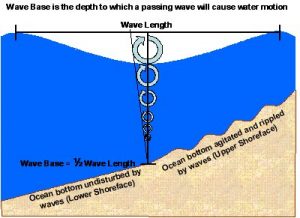
The circular motion of water particles diminishes with depth and is negligible at about one-half wavelength, an important dimension to remember in connection with waves. Wave base is the vertical depth at which water ceases to be disturbed by waves. In water shallower than wave base, waves will disturb the bottom and ripple shore sand. Wave base occurs at a depth of about one-half wavelength, where the water particles’ circular motion diminishes to zero. If waves approaching a beach have crests at about 6 m (~20 ft) intervals, this wave motion disturbs water to about 3 m (~10 ft) deep. This motion is known as fair-weather wave base. In strong storms such as hurricanes, both wavelength and wave base increase dramatically to a depth known as storm wave base, which is approximately 91 m (~300 ft) [1].
Waves are generated by wind blowing across the ocean surface. The amount of energy imparted to the water depends on wind velocity and the distance across which the wind is blowing. This distance is called fetch. Waves striking a shore are typically generated by storms hundreds of miles from the coast and have been traveling across the ocean for days.
![By Fffred~commonswiki (based on copyright claims). (Own work) [Public domain], <a href="https://commons.wikimedia.org/wiki/File%3AWave_packet_(dispersion).gif">via Wikimedia Commons</a> The wave moves across the image.](https://opengeology.org/textbook/wp-content/uploads/2016/07/Wave_packet_dispersion.gif)
12.1.1 Behavior of Waves Approaching Shore
![By Kraaiennest [<a href="http://creativecommons.org/licenses/by-sa/3.0">CC BY-SA 3.0</a> or <a href="http://www.gnu.org/copyleft/fdl.html">GFDL</a>], <a href="https://commons.wikimedia.org/wiki/File%3ABreaking_wave_types.svg">via Wikimedia Commons</a>: This file is licensed under the Creative Commons Attribution-Share Alike 3.0 Unported license. There are four types of breakers](https://opengeology.org/textbook/wp-content/uploads/2016/07/Breaking_wave_types.svg_-238x300.png)
![Source: By Régis Lachaume (Own work) [<a href="http://www.gnu.org/copyleft/fdl.html">GFDL</a> or <a href="http://creativecommons.org/licenses/by-sa/3.0/">CC-BY-SA-3.0</a>], <a href="https://commons.wikimedia.org/wiki/File%3APropagation_du_tsunami_en_profondeur_variable.gif">via Wikimedia Commons</a> The waves get taller in shallow water.](https://opengeology.org/textbook/wp-content/uploads/2016/07/Propagation_du_tsunami_en_profondeur_variable-300x157.gif)
[ays_quiz id=”78″]
12.2 Shoreline Features
Coastlines are dynamic, high energy, and geologically complicated places where many different erosional and depositional features exist (see Chapter 5). They include all parts of the land-sea boundary directly affected by the sea, including land far above high tide and seafloor well below normal wave base. But, the shoreline itself is the direct interface between water and land that shifts with the tides. This shifting interface at the shoreline is called the littoral zone. The combination of waves, currents, climate, coastal morphology, and gravity, all act on this land-sea boundary to create shoreline features.
12.2.1 Shoreline Zones
![Source: US Navy, [Public domain], <a href="https://commons.wikimedia.org/wiki/File%3ALittoral_Zones.jpg">via Wikimedia Commons</a> The image shows the many complexities of the shoreline described in the text.](https://opengeology.org/textbook/wp-content/uploads/2016/07/Littoral_Zones-300x132.jpg)
The foreshore zone overlaps the surf zone and is periodically wet and dry due to waves and tides. The foreshore zone is where planer-laminated, well-sorted sand accumulates. The beach face is the part of the foreshore zone where the breaking waves swash up and the backwash flows back down. Low ridges above the beach face in the foreshore zone are called berms. During the summer in North America, when most people visit the beach, the zone where people spread their towels and beach umbrellas is the summer berm. Wave energy is typically lower in the summer, which allows sand to pile onto the beach. Behind the summer berm is a low ridge of sand called the winter berm. In winter, higher storm energy moves the summer berm sand off the beach and piles it in the nearshore zone. The next year, that sand is replaced on the beach and moved back onto the summer berm. The backshore zone is the area always above sea level in normal conditions. In the backshore zone, onshore winds may blow sand behind the beach and the berms, creating dunes.
12.2.2 Refraction, Longshore Currents, and Longshore Drift
![Source: By USGS/USGov, modified by Eurico Zimbres [Public domain], <a href="https://commons.wikimedia.org/wiki/File%3ALongshore_i18n.png">via Wikimedia Commons</a> The waves move sand along the beach.](https://opengeology.org/textbook/wp-content/uploads/2016/07/Longshore-195x300.png)
![Source: By NASA/GSFC/METI/ERSDAC/JAROS, and U.S./Japan ASTER Science Team (NASA's Earth Observatory) [Public domain], <a href="https://commons.wikimedia.org/wiki/File%3AFarewell_Spit.jpg">via Wikimedia Commons</a> The spit is a long ridge of sand](https://opengeology.org/textbook/wp-content/uploads/2016/07/FarewellSpitNZ-300x193.jpg)
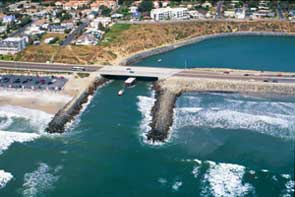
One way to keep a harbor open is to build a jetty, a long concrete or stone barrier constructed to deflect the sand away from a harbor mouth or other ocean waterway. If the jetty does not deflect the sand far enough out, sand may continue to flow along the shore, forming a spit around the end of the jetty. A more expensive but effective method to keep a bay mouth open is to dredge the sand from the growing spit, put it on barges, and deliver it back to the drift downstream of the harbor mouth. An even more expensive but more effective option is to install large pumps and pipes to draw in the sand upstream of the harbor, pump it through pipes, and discharge it back into the drift downstream of the harbor mouth. Because natural processes work continuously, human efforts to mitigate inconvenient spits and baymouth bars require ongoing modifications. For example, the community of Santa Barbara, California, tried several methods to keep their harbor open before settling on pumps and piping [2].
![Source: By National Weather Service, Wilmington, NC (NOAA) [Public domain], <a href="https://commons.wikimedia.org/wiki/File%3ABackcomp.gif">via Wikimedia Commons</a> Some water is rushing outwards while most water rushes in toward the shore.](https://opengeology.org/textbook/wp-content/uploads/2016/07/RipCurrent-300x300.gif)
Like rip currents, undertow is a current that moves away from the shore. However, unlike rip currents, undertow occurs underneath the approaching waves and is strongest in the surf zone where waves are high and water is shallow. Undertow is another return flow for water transported onshore by waves.
12.2.3 Emergent and Submergent Coasts
![Source: Diliff [<a href="http://creativecommons.org/licenses/by-sa/3.0">CC BY-SA 3.0</a> or <a href="http://www.gnu.org/copyleft/fdl.html">GFDL</a>], <a href="https://commons.wikimedia.org/wiki/File%3AIsland_Archway%2C_Great_Ocean_Rd%2C_Victoria%2C_Australia_-_Nov_08.jpg">via Wikimedia Commons</a> The arch is a rock in the water with a hole in the middle which allows water to pass through.](https://opengeology.org/textbook/wp-content/uploads/2016/07/Island_Archway_Great_Ocean_Rd_Victoria_Australia_-_Nov_08-300x106.jpg)
![Source: By 663highland (663highland) [<a href="http://www.gnu.org/copyleft/fdl.html">GFDL</a>, <a href="http://creativecommons.org/licenses/by-sa/3.0/">CC-BY-SA-3.0</a> or <a href="http://creativecommons.org/licenses/by/2.5">CC BY 2.5</a>], <a href="https://commons.wikimedia.org/wiki/File%3AAngel_Road_Shodo_Island_Japan01s3.jpg">via Wikimedia Commons</a> The rock in the ocean is connected by the sandy tombolo.](https://opengeology.org/textbook/wp-content/uploads/2016/07/Angel_Road_Shodo_Island_Japan01s3-300x200.jpg)
![Source: By Wilson44691 [Public domain], <a href="https://commons.wikimedia.org/wiki/File%3AWaveCutPlatformsAntelopeIslandUT.jpg">via Wikimedia Commons</a>](https://opengeology.org/textbook/wp-content/uploads/2016/07/WaveCutPlatformsAntelopeIslandUT-300x104.jpg)
![Source: By Landsat/NASA [Public domain], <a href="https://commons.wikimedia.org/wiki/File%3AChesapeakelandsat.jpeg">via Wikimedia Commons</a> The area is a filled-in river valleys.](https://opengeology.org/textbook/wp-content/uploads/2016/07/Chesapeakelandsat-300x225.jpeg)
![Source: By Foxbat deinos (Own work) [Public domain], <a href="https://commons.wikimedia.org/wiki/File%3ATidal_flat_general_sketch.png">via Wikimedia Commons</a> The tidal flat it a network of channels.](https://opengeology.org/textbook/wp-content/uploads/2017/02/Tidal_flat_general_sketch-300x225.png)
Geologically, tidal flats are broken into three different sections: barren zones, marshes, and salt pans. These zones may be present or absent in each individual tidal flat. Barren zones are areas with strong flowing water, coarser sediment, with ripple marks and cross bedding common. Marshes are vegetated with sand and mud. Salt pans or flats, less often submerged than the other zones, are the finest-grained parts of tidal flats, with silty sediment and mud cracks (see Chapter 5) [4].
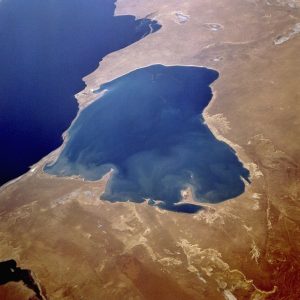
Lagoons are locations where spits, barrier islands, or other features partially cut off a body of water from the ocean. Estuaries are a vegetated type of lagoon where fresh water flows into the area making the water brackish—a salinity between salt and fresh water. However, terms like lagoon, estuary, and even bay are often loosely used in place of one another [5]. Lagoons and estuaries are certainly transitional between land and water environments where littoral, shallow shorelines; lacustrine, lakes or lagoons; and fluvial, rivers or currents can overlap. For more information on lagoons and estuaries, see Chapter 5.
12.2.4 Human impact on coastal beaches
![Source: By Archer0630 (Own work) [<a href="http://creativecommons.org/licenses/by-sa/3.0">CC BY-SA 3.0</a>], <a href="https://commons.wikimedia.org/wiki/File%3AGroin_effect-3.JPG">via Wikimedia Commons</a> The sediment piled on one side and removed from the other.](https://opengeology.org/textbook/wp-content/uploads/2016/07/Groin_effect-300x240.jpg)
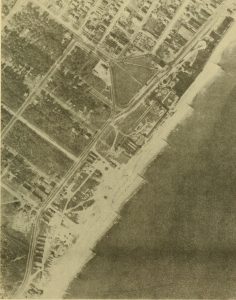
Jetties are large manmade piles of boulders or concrete barriers built at river mouths and harbors. A jetty is designed to divert the current or tide, to keep a channel to the ocean open, and to protect a harbor or beach from wave action. Groins are similar but smaller than jetties. Groins are fences of wire, wood or concrete built across the beach perpendicular to the shoreline and downstream of a property. Unlike jetties, groins are used to preserve sand on a beach rather than to divert it. Sand erodes on the downstream side of the groin and collects against the upstream side. Every groin on one property thus creates a need for another one on the property downstream. A series of groins along a beach develops a scalloped appearance along the shoreline.
Inland streams and rivers flow to the ocean carrying sand to the longshore current which distributes it to beaches. When dams are built, they trap sand and keep sediment from reaching beaches. To replenish beaches, sand may be hauled in from other areas by trucks or barges and dumped on the depleted beach. Unfortunately, this can disrupt the ecosystem that exists along the shoreline by exposing native creatures to foreign ecosystems and microorganisms and by introducing foreign objects to humans. For example, visitors to one replenished east coast beach found munitions and metal shards in the sand, which had been dredged from abandoned military test ranges [6].
![Source: By Internet Archive Book Images [<a href="https://www.flickr.com/commons/usage/">No restrictions</a>], <a href="https://commons.wikimedia.org/wiki/File%3ABulletin_of_the_Beach_Erosion_Board_(1948)_(20255015848).jpg">via Wikimedia Commons</a> A tombolo formed behind the breakwater at Venice, CA](https://opengeology.org/textbook/wp-content/uploads/2016/07/Venice_CA_breakwater_Bulletin_of_the_Beach_Erosion_Board_1948_20255015848-cropped-273x300.jpg)
12.2.5 Submarine Canyons
![Source: By United States Geological Survey ([1]) [Public domain], <a href="https://commons.wikimedia.org/wiki/File%3ACanyons_off_LA.jpg">via Wikimedia Commons</a> The canyons are carved into the slope.](https://opengeology.org/textbook/wp-content/uploads/2016/07/Canyons_off_LA-300x213.jpg)
[ays_quiz id=”79″]
12.3 Currents and Tides
Ocean water moves as waves, currents, and tides. Ocean currents are driven by persistent global winds blowing over the water’s surface and by water density. Ocean currents are part of Earth’s heat engine in which solar energy is absorbed by ocean water and distributed by ocean currents. Water has a unique property, high specific heat, that relates to ocean currents. Specific heat is the amount of heat necessary to raise a unit volume of a substance one degree. For water it takes one calorie per cubic centimeter to raise its temperature one degree Celsius, a specific heat much greater than most other natural substances. This means the oceans, covering 71% of the Earth’s surface, soak up solar heat with little temperature change and distribute that heat around the Earth by ocean currents. The high specific heat of water makes the Earth habitable.
![By Dr. Michael Pidwirny (see http://www.physicalgeography.net) [Public domain], <a href="https://commons.wikimedia.org/wiki/File%3ACorrientes-oceanicas.png">via Wikimedia Commons</a> Warm currents are red, blue currents are blue.](https://opengeology.org/textbook/wp-content/uploads/2016/07/Corrientes-oceanicas-300x157.png)
12.3.1 Surface Currents
The Earth’s rotation and the Coriolis effect exert significant influence on ocean currents (see Chapter 13). In the figure, the black arrows show global surface currents. Notice the large circular currents in the northern and southern hemispheres in the Atlantic, Pacific, and Indian Oceans. These currents are called gyres and are driven by atmospheric circulation and air movement [9]. Gyres rotate clockwise in the northern hemisphere and counterclockwise in the southern hemisphere because of the Coriolis Effect. Western boundary currents flow from the equator toward the poles carrying warm water. They are key contributors to local climate. Western boundary currents are narrow and move poleward along the east coasts of adjacent continents. The Gulf Stream and the Kuroshio currents in the northern hemisphere and the Brazil, Mozambique, and Australian currents in the southern hemisphere are western boundary currents. Currents returning cold water toward the equator are broad and diffuse along the western coasts of adjacent land masses. These warm western boundary and cold eastern boundary currents affect climate of nearby lands making them warmer or colder than other areas at equivalent latitudes. For example, the warm Gulf Stream makes Northern Europe much milder than similar latitudes in northeastern Canada and Greenland. Another example is the cool Humboldt Current, also called the Peru Current, flowing north along the west coast of South America. Cold currents limit evaporation in the ocean, which is one reason the Atacama Desert in Chile is cool and arid [10].
12.3.2 Deep Currents
![Source: By Robert Simmon, NASA. Minor modifications by Robert A. Rohde also released to the public domain (NASA Earth Observatory) [Public domain], <a href="https://commons.wikimedia.org/wiki/File%3AThermohaline_Circulation_2.png">via Wikimedia Commons</a> In certain areas, the current sinks or rises.](https://opengeology.org/textbook/wp-content/uploads/2016/07/Thermohaline_Circulation-300x188.png)
Evaporation and freshwater influx from rivers affect salinity and, therefore, the density of seawater. As the western boundary currents cool at high latitudes and salinity increases due to evaporation and ice formation (recall that ice floats and water is densest just above its freezing point). So the cold, denser water sinks to become the ocean’s deep waters. Deep-water movement is called thermohaline circulation—thermo refers to temperature, and haline refers to salinity. This circulation connects the world’s deep ocean waters. Movement of the Gulf Stream illustrates the beginning of thermohaline circulation. Heat in the warm poleward moving Gulf Stream promotes evaporation which takes heat from the water and as heat thus dissipates, the water cools. The resulting water is much colder, saltier, and denser. As the denser water reaches the North Atlantic and Greenland, it begins to sink and becomes a deep-water current. As shown in the illustration above, this worldwide connection between shallow and deep-ocean circulation overturns and mixes the entire world ocean, bringing nutrients to marine life, and is sometimes referred to as the global conveyor belt [11].
12.3.3 Tides
Tides are the rising and lowering of sea level during the day and are caused by the gravitational effects of the Sun and Moon on the oceans [12]. The Earth rotates daily within the Moon and Sun’s gravity fields. Although the Sun is much larger and its gravitational pull is more powerful, the Moon is closer to Earth; hence, the Moon’s gravitational influence on tides is dominant. The magnitude of the tide at a given location and the difference between high and low tide—the tidal range, depends primarily on the configuration of the Moon and Sun with respect to the Earth’s orbit and rotation. Spring tide occurs when the Sun, Moon, and Earth line up with each other at the full or new Moon, and the tidal range is at a maximum. Neap tide occurs approximately two weeks later when the Moon and Sun are at right angles with the Earth, and the tidal range is lowest.
![Source: By User:KVDP, SVG conversion by Surachit [Public domain], <a href="https://commons.wikimedia.org/wiki/File%3ATide_schematic.svg">via Wikimedia Commons</a> High tide aligns with the moon](https://opengeology.org/textbook/wp-content/uploads/2016/07/Tide_schematic.svg_-300x168.png)
![Source: By Snubcube (Own work) [<a href="http://creativecommons.org/publicdomain/zero/1.0/deed.en">CC0</a>], <a href="https://commons.wikimedia.org/wiki/File%3ATide_type.svg">via Wikimedia Commons</a> Each tide has a different curve.](https://opengeology.org/textbook/wp-content/uploads/2016/07/Tide_type.svg_-198x300.png)
![Source: By KVDP (Own work) [Public domain], <a href="https://commons.wikimedia.org/wiki/File%3ADiurnal_tide_types_map.jpg">via Wikimedia Commons</a> The map shows locations of the different tide types.](https://opengeology.org/textbook/wp-content/uploads/2016/07/Diurnal_tide_types_map-300x147.jpg)
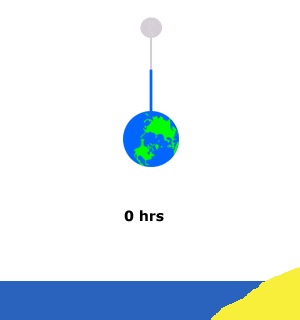
is complicated and can be done for only a few days at a time. Tidal phases are determined by bathymetry: the depth of ocean basins and the continental obstacles that are in the way of the tidal envelope within which the Earth rotates. Local tidal experts make 48-hour tidal forecasts using tidal charts based on daily observations, as can be seen in the chart of different tide types. A typical tidal range is approximately 1 m (3 ft). Extreme tidal ranges occur where the tidal wave enters a narrow restrictive zone that funnels the tidal energy. An example is the English Channel between Great Britain and the European continent where the tidal range is 7 to 9.75 m (23 to 32 ft). The Earth’s highest tidal ranges occur at the Bay of Fundy, the funnel-like bay between Nova Scotia and New Brunswick, Canada, where the average range is nearly 12 m (40 ft) and the extreme range is around 18 m (60 ft). At extreme tidal range locations, a person who ventures out onto the seafloor exposed during ebb tide may not be able to outrun the advancing water during flood tide. NOAA has additional information on tides.
[ays_quiz id=”80″]
Summary
Shoreline processes are complex, but important for understanding coastal processes. Waves, currents, and tides are the main agents that shape shorelines. Most coastal landforms can be attributed to moving sand via longshore drift, and long-term rising or falling sea levels.
The shoreline is the interface between water and land and is divided into five zones. Processes at the shoreline are called littoral processes. Waves approach the beach at an angle, which cause the waves to bend towards the beach. This bending action is called wave refraction and is responsible for creating the longshore current and longshore drift—the process that moves sand along the coasts. When the longshore current deposits sand along the coast into quieter waters, the sand can accumulate, creating a spit or barrier called a baymouth bar, which often blocks bays and harbors. Inconvenienced humans create methods to keep their harbors open and preserve sand on their beaches by creating jetties and groins, which negatively affect natural beach processes.
Emergent coasts are created by sea levels falling, while submergent coasts are caused by sea levels rising. Oceans absorb solar energy, which is distributed by currents throughout the world. Circular surface currents, called gyres, rotate clockwise in the northern hemisphere and counterclockwise in the southern hemisphere. Thermohaline deep circulation connects the world’s deep ocean waters: when shallow poleward moving warm water evaporates and cools, the colder, saltier, and denser water sinks and becomes deep-water currents. The connection between shallow and deep-ocean circulation is called the global conveyor belt.
Tides are the rising and lowering of sea level during the day and are caused by the gravitational effects of the Sun and Moon on the oceans. There are three types of tidal patterns: diurnal, semidiurnal, and mixed. Typical tidal ranges are approximately 1 m (3 ft). Extreme tidal ranges are around 18 m (60 ft).
[ays_quiz id=”81″]
References
- Colling, Angela. 2001. Ocean Circulation. Edited by Open University Course Team. Butterworth-Heinemann.
- Davis, Richard A., Jr., and Duncan M. Fitzgerald. 2009. Beaches and Coasts. John Wiley & Sons.
- Davis, Richard Albert. 1997. The Evolving Coast. Scientific American Library New York.
- Greene, Paul, George Follett, and Clint Henker. 2009. “Munitions and Dredging Experience on the United States Coast.” Marine Technology Society Journal 43 (4): 127–31.
- Jackson, Nancy L., Mitchell D. Harley, Clara Armaroli, and Karl F. Nordstrom. 2015. “Beach Morphologies Induced by Breakwaters with Different Orientations.” Geomorphology 239 (June). Elsevier: 48–57.
- “Littoral Bypassing and Beach Restoration in the Vicinity of Port Hueneme, California.” n.d. In Coastal Engineering 1966.
- Munk, Walter H. 1950. “ON THE WIND-DRIVEN OCEAN CIRCULATION.” Journal of Meteorology 7 (2): 80–93.
- Normark, William R., and Paul R. Carlson. 2003. “Giant Submarine Canyons: Is Size Any Clue to Their Importance in the Rock Record?” Geological Society of America Special Papers 370 (January): 175–90.
- Reineck, H-E, and Indra Bir Singh. 2012. Depositional Sedimentary Environments: With Reference to Terrigenous Clastics. Springer Science & Business Media.
- Rich, John Lyon. 1951. “THREE CRITICAL ENVIRONMENTS OF DEPOSITION, AND CRITERIA FOR RECOGNITION OF ROCKS DEPOSITED IN EACH OF THEM.” Geological Society of America Bulletin 62 (1). gsabulletin.gsapubs.org: 1–20.
- Runyan, Kiki, and Gary Griggs. 2005. “Implications of Harbor Dredging for the Santa Barbara Littoral Cell.” In California and the World Ocean ’02, 121–35. Reston, VA: American Society of Civil Engineers.
- Schwiderski, Ernst W. 1980. “On Charting Global Ocean Tides.” Reviews of Geophysics 18 (1): 243–68.
- Stewart, Robert H. 2008. Introduction to Physical Oceanography. Texas A & M University Texas.
- Stommel, Henry, and A. B. Arons. 2017. “On the Abyssal Circulation of the World ocean—I. Stationary Planetary Flow Patterns on a Sphere – ScienceDirect.” Accessed February 26. http://www.sciencedirect.com/science/article/pii/0146631359900656.
- Stommel, Henry, and A. B. Arons. 2017. “On the Abyssal Circulation of the World ocean—I. Stationary Planetary Flow Patterns on a Sphere – ScienceDirect.” Accessed February 26. http://www.sciencedirect.com/science/article/pii/0146631359900656
